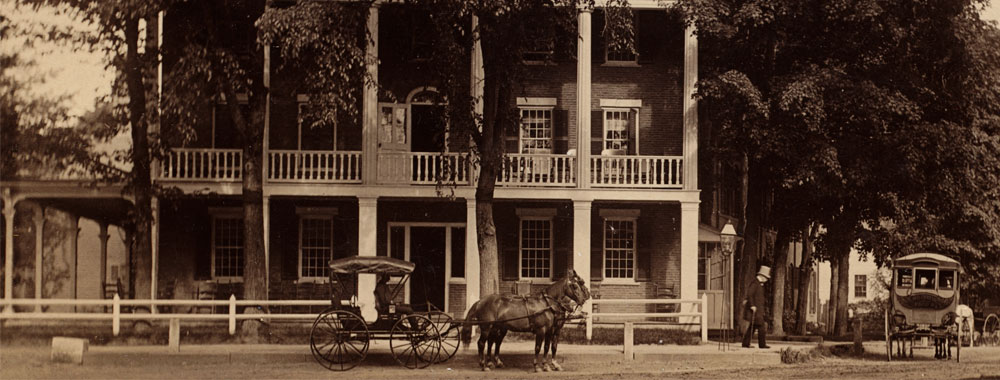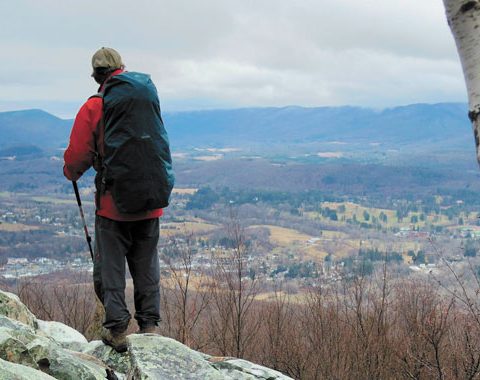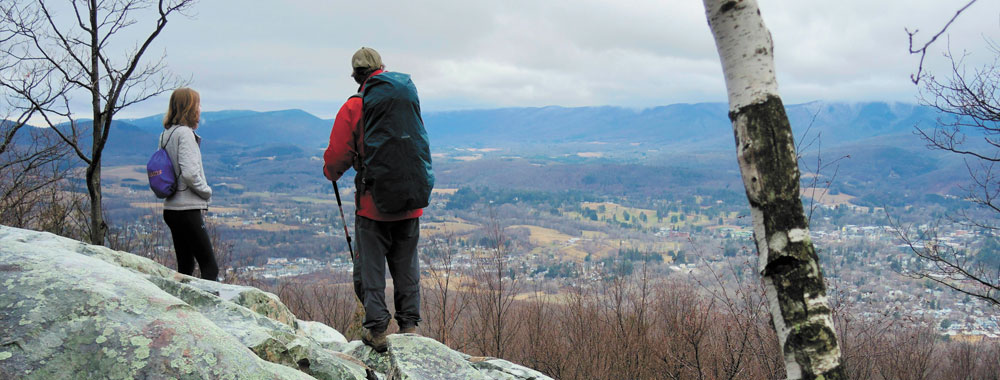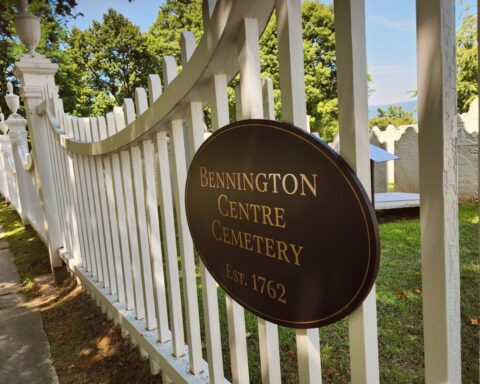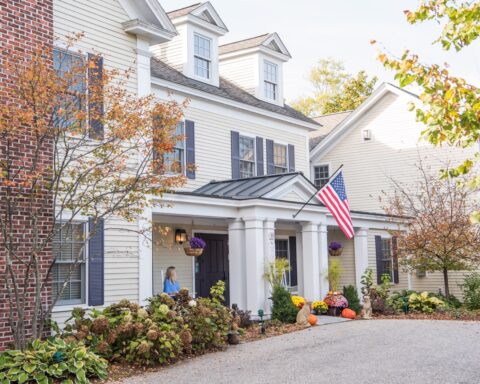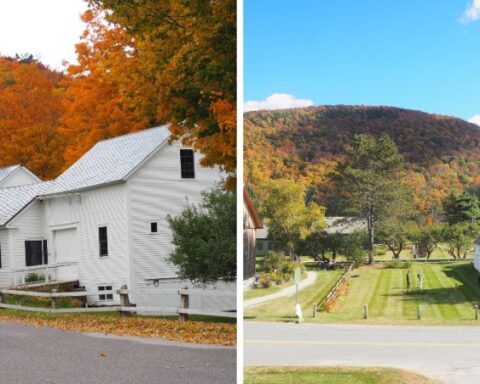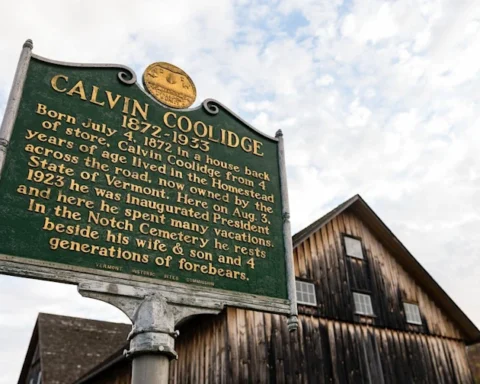The iconic Berkshire town turns 250.

By Clarence Fanto
Photos courtesy of Amy Lafave and the Lenox Library Association
On a late winter night in 1767, one of Berkshire County’s earliest settlements was incorporated as a town. It happened at the first Proprietors Meeting held at the home of Israel Dewey on March 5.
That gathering of pioneering settlers yielded a new name out of the former Yokuntown (named after a Native American chief) and officially separated Lenox from Richmond (formerly Mount Ephraim) on the other side of a then-formidable ridge line.
This year, Lenox is celebrating the 250th anniversary of its founding by honoring its heritage and looking ahead to the future as the health and wellness resort center of the region.
Designated as Lot No. 8, the area had been auctioned in 1762 as part of the Massachusetts General Court’s mission to settle Berkshire County, formed a year earlier, with the sale of 10 potential township lots, according to Lenox historian George H. Tucker’s unpublished 1935 historical manuscript. The region had been home to the Mahican tribe, clustered along the Housatonic River.
The town’s new name was misspelled by a clerk during the incorporation meeting; it was meant to honor British politician and Army Officer Charles Lennox, third duke of Richmond and Lennox, who became a fervent supporter of the breakaway American colonists before and during the Revolutionary War.
With its stagecoach stop, the town quickly became a bustling community of farmers, tradespeople, tavern owners and industrial workers in Lenox Furnace, soon to be known as the village of Lenox Dale along the Housatonic River.
The town was designated as the county seat in 1787, a title it held until 1868, when the honors passed to Pittsfield. An imposing courthouse, replacing the original, was built in 1815 and was transformed into the Lenox Library in 1871 as the center of community life.
Notable residents
Starting in the mid-19th century, Lenox and its neighbor, Stockbridge drew famed authors and actors as Fanny Kemble, Catherine Sedgwick, Nathaniel Hawthorne and Edith Wharton, to name but a few — took up residence as the town vied with Newport, R.I., as a magnet for the rich and famous.
Grand estates, known as “Cottages,” were built during the Gilded Age and serviced by a melting pot of immigrants who formed close bonds with their employers. Families with deep roots going back multiple generations continue to play a prominent role in town life.
Thomas Romeo still lives on the same property his grandfather purchased in early 1900s.
“With all these estates, we had Irish, French, Italian working on them,” Romeo says. “We were able to maintain our open space. People worked incredibly hard and were incredibly successful at what they did.”

Descendants of the long-established families recall growing up in a safe, nurturing environment fueled by a vibrant manufacturing and service economy.
“Unlike today, with all kinds of security concerns, we roamed the neighborhoods,” recalls David Roche, a fourth-generation native whose great-grandfather from Ireland was sworn in as a naturalized U.S. citizen at the county courthouse in 1860 and raised nine children in Lenox.
Roche, now a selectman, remembers “an idyllic time.”
“We were always out playing sports and enjoying the outdoors. We had a small but really good school system that prepared us well, whether we went to college or to work at the General Electric. Everybody knew everyone.”
Another native, Amy Lafave, a town historian and director of the Lenox Library, reminisces about “walking to the library after school and then walking home with a stack of books.”
As the daughter of the high school basketball coach, she was the youngest member of the Lenox High Pep Club.

“The night the boys won the state championship in 1974, I was 9 and got to stay up past midnight, riding behind the Fire Department caravan in one of our seven school buses,” she says.
Like most other natives, Lafave is fond of the high school sports teams’ Millionaires moniker.
“It’s a mistaken notion that the nickname is there because all the kids are rich and come from wealthy families,” she declares. “That’s not the case and never has been. Because the Cottager era was such an important part of our history, there’s some vestige of that period still with us.”
She calls it “a unique nickname, it’s pretty neat to have it and I’m very proud of it. You had millionaires and gardeners all working together to sign a document agreeing to the building of a new high school [in 1908]. We weren’t millionaires monetarily, but we were rich in other things.”
Roche also is keen on the Millionaires nickname: “We relied on the Cottagers for many of the buildings and accoutrements in our town, and I hope they don’t change it in my lifetime.”
The Village of Lenox Dale
As a self-contained, proud village, Lenox Dale has forged its own identity as an industrial center, always a part of Lenox but also aligned with the adjacent town of Lee.

“It was very close-knit,” recalls Timothy Sheehan, senior officer of the Lenox Police and a third-generation native of The Dale, as residents call it fondly.
“I was a paperboy so I knew everyone in every house,” he says. “If you ever were in any trouble, you could go to any house and they’d let you in, call your mother or father. But if you got in trouble, they weren’t afraid to grab you by the neck, give you a boot in the rear if you needed it, and then call your parents and tell them what you did.”
“It’s beautiful country down there,” Sheehan explains. “We’re at the base of October Mountain, it was our neighbor and so was the Housatonic. I love the Dale. I wouldn’t change it for anything in the world.”
But change and challenge are inevitable, even in the village where everybody knows your name.
“All of the core families are still around,” Sheehan notes. “They’ll never leave but many young people have gone because there weren’t any jobs, which is sad. When I was a kid, everyone worked for Smith Paper or GE, but times change and the cost of living in Lenox, including the Dale, is astronomical.”
But Sheehan describes himself as “the luckiest person in the world.”
“I grew up in the neighborhood my mother did, and my kids grew up in the neighborhood I did. You don’t hear that too often. I’m two or three houses from where I grew up.”
He remembers that “people in my mother’s generation and before hers kind of looked down on the Dale, but that’s not so any more. Our voice is being heard more than it used to be.”
Home of Hospitality
Lenox, formerly a bedroom community for well-paid employees of GE in Pittsfield, has attracted tourists for more than 150 years, but in recent decades the hospitality industry — fueled by Tanglewood, Shakespeare & Company, The Mount and the area’s scenic beauty — has become the town’s economic lifeblood.
As the paper mills in Lee shut down and GE faded away, “we became more and more of a tourist town.” Roche emphasizes. “Now people who have more money recognize the Berkshires as a great place to vacation. We spend a lot more effort and time catering to the needs of the second-home owners and the tourists than we did back then.”
Lafave wants to encourage more small businesses, “cottage industry jobs that provide more of a living wage for folks. There’s a rapidly shrinking middle class so I hope to see things happen that encourage middle class families to move to town to aid the community’s sustainability.”
But the hospitality industry emerges as “a win-win situation” in Sheehan’s view. “It’s almost like we’re going back to the same thing, it’s just a different form, nothing wrong with that. There’s people working for them and at the places that serve them, good jobs with good benefits.”
He extols Canyon Ranch, opened in 1989 after the Bellefontaine estate had been vacant for a decade, as “one of the best things that’s happened to Lenox.”

“They’re quiet, they don’t bother anybody, they take in a ton of taxes and revenue for the town, plus they give jobs, that’s what we’re looking for. It’s beautiful, pristine, they could have torn it down, but they did a great job, preserved it, and from the street it still looks like Bellefontaine.”
The development of Tanglewood on the donated Tappan estate, beginning in 1937, firmly established Lenox and its neighbor Stockbridge as a cultural hub and prime attraction. Down the road on the farm property of the Wheatleigh estate, the Music Inn opened in 1950, showcasing some of the great names in jazz, folk, soul and rock for nearly 30 years.
Now, Roche’s fondest hope for the town is “that it doesn’t lose sight of its past and it stays on a path that preserves the heritage.”
Citing the community’s dedication to maintaining open space, he finds that “it adds a lot of value to the town. People want to get away from where they’re from, and they want to come to the town that Lenox was and hopefully will remain.”
A Lenox Timeline
Click photos to view full size.
1767: The first Proprietors meeting (forerunner of the Select Board) is held at the home of Israel Dewey, either at what’s now the Birchwood Inn opposite the Church on the Hill, or at his log cabin on East Street (sources differ). The area previously known as Yokuntown, including Richmond, was first inhabited by Mahican Native Americans. It became the home of European settlers in 1750 when Jonathan and Sarah Hinsdale of Hartford, Conn., established a small inn and general store on Old Stockbridge Road, near Hawthorne Street.
1770: The Village Inn on Church Street opens as the first of the downtown village’s lodging establishments and taverns.
1774: Heads of households in Lenox joined other colonists in signing on to the non-consumption agreements, a forerunner of the American Revolution. Not everybody was a revolutionary. In 1776, Loyalist Gideon Smith hid in a cleft in the woods near Roaring Brook, afterwards known as Tory Cave.
1780s: Job Gilbert establishes an iron works in Lenox Dale, first known as Lenox Furnace, after discovery of a vein of iron ore spurs mine excavation under the town. Lenox families also subsisted on farming, sawmills, textile mills, glassworks, and quarrying.

1787: Lenox is established as the Berkshire County seat. In 1815, the second county courthouse is built, replacing the original on Old Stockbridge Road. In 1868, Pittsfield was designated as the county seat. In 1871, the former courthouse became the Lenox Library.
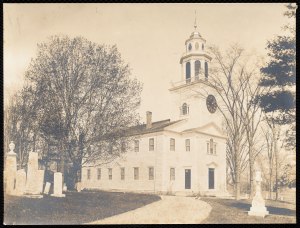
1806: The Church on the Hill, a congregation formed in 1769, opens on Main Street at the town’s highest point. Other notable historic churches downtown include St. Ann’s Roman Catholic Church (its current Norman Gothic Revival style building opened in 1911, replacing the earlier church built in 1870) and Trinity Episcopal (built in 1888, also Gothic Revival style).
1821: Catherine Sedgwick moves to Lenox, the first in a long line of authors, artists, actors (Fanny Kemble, Herman Melville, Nathaniel Hawthorne, Edith Wharton) who established homes in the town as well as adjacent Stockbridge and Pittsfield, drawn by the region’s scenic appeal.

1829: Anchoring the downtown at 6 Main St., the Berkshire Coffee House opened. It was renamed the Curtis Hotel in 1853 after its new owner, William O. Curtis, and eventually grew to a four-story Georgian/Colonial Revival architectural gem. After a downward spiral in the mid-20th century, the town acquired the building in 1979 for state-subsidized senior housing, with first-floor retail spaces including what became the only in-town pharmacy.

1844: The town’s first estate, Highwood, is created by banker Samuel Gray Ward of Boston. The Italianate mansion was the forerunner of the Berkshire Cottage era, which peaked with about 70 properties during the Gilded Age from the 1870s to the early 1900s. Like similar estates, Highwood was just over the town line in Stockbridge but was considered part of Lenox. The Pinecroft Estate followed in 1854 at Schermerhorn Park.

1848: Industry is at full steam in Lenox Dale with the opening of Lenox Iron Co., followed by Lenox Glass Works in 1853.

1853: Blossom Hill, now the site of Miraval/Cranwell Resort, is purchased by the Rev. Henry Ward Beecher for $4,500. Beecher’s cottage was moved to make way for Wyndhurst, built for Gen. John Rathbone in 1869. This summer home was torn down in
1894: by John Sloane and replaced by the present Tudor mansion. In 1925, it became the Berkshire Hunt and Country Club. Purchased in 1930 by Edward Cranwell, it passed to the Society of Jesus of New England in 1939, then The Cranwell School, a prep academy for boys, from 1939 to 1975. It was developed into a luxury resort and golf course in 1993.
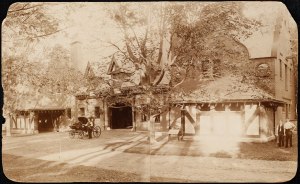
1893: Ventfort Hall is constructed as a summer cottage for Sarah and Henry Morgan. Saved from a developer’s wrecking ball in the early 1990s, it was established as the Ventfort Mansion and Museum of the Gilded Age by volunteer donors in 1997.

1902: The Mount opens as the home of famed author Edith Wharton, who lived there until 1911. It has housed the Foxhollow School for Girls, and from 1978-2000 as the first home of Shakespeare & Company. In 1997, the Edith Wharton Restoration began rehabilitation of the mansion, stables and grounds, requiring the theater troupe to relocate to its present site on Kemble Street, former home of the Lenox School for Boys (1926-1971) and controversial religious sect, The Bible Speaks (1977-1987).

1902: The imposing Aspinwall Hotel is built by lawyer, business executive and former Civil War officer Thomas H. Hubbard on 400 hilltop acres in what later became Kennedy Park. It was the county’s largest hotel at the time, with 225 guest rooms hosting notables such as Theodore Roosevelt, Franklin D. Roosevelt and John D. Rockefeller Sr. In 1931, it burned to the ground in a devastating fire.
1903: Lenox Station at the foot of Housatonic Street opens for passenger service, mail and freight arriving on the New York, New Haven and Hartford Railroad. It replaces the original 1850 station built by the Stockbridge & Pittsfield Railroad and destroyed by fire in 1901. The town also had train stations at Lenox Depot (Lenox Dale) and North Lenox. A trolley line delivered mail and packages up Housatonic Street (then called Depot Street) from 1903 into the 1920s.

1909: The so-called Easter fire demolishes much of downtown, leading to the formal establishment of the town’s Fire Department.
1910: Harris Fahnestock builds a brick mansion on East Street. After several years as the Duncan School for Boys, the 500-acre site was bought by Civil War buff George Bisacca and opened as the Eastover Resort in 1947. It was closed in 2009 by his daughter, Dorothy “Ticki” Winsor, who sold it a year later to HG October Mountain LLC, which operates the property as the holistic-oriented Eastover Retreat and Estate.
1937: The Tappan family estate, donated to the Boston Symphony a year earlier, hosts the first Tanglewood BSO concert under a tent. After a sudden thunderstorm disrupts the second concert in mid-August, funding is raised for The Shed, which was inaugurated in 1938 amid great fanfare. In 1940, BSO Music Director Serge Koussevitzky opens the orchestra’s training academy, then known as the Berkshire Music Center. In 1986, the adjoining Highwood mansion and grounds are sold to the BSO, and in 1994 Ozawa Hall opened.
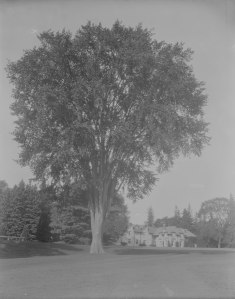
1944: The progressive Windsor Mountain School opens at Groton Place, the former Winthrop estate, on West Street in Lenox, at the height of the private school era in the town. Five years after it closed in 1975, the property was acquired by Boston University for its summer program aimed at high-school musicians (the Boston University Tanglewood Institute, founded in 1966).
1949: The state begins construction of a four-lane bypass on Route 7 and 20, avoiding the downtown historic district and commercial center of Lenox. In 1966, a proposal to extend and widen the bypass around Pittsfield eventually failed because of community and environmental opposition. By 2000, the two-lane highway north of downtown Lenox had been widened to four lanes and improved all the way to Dan Fox Drive in Pittsfield.

1950: The Wheatleigh property, geographically just over the town line in Stockbridge, houses the Lenox School for Jazz, which evolved into the famed Music Inn, hosting concerts by leading rock, pop, folk and blues artists until it closed in 1979 and converted into the White Pines condos in the 1980s.
1956: Lenox firefighters save all but three priests and a lay brother among Shadow Brook’s 125 residents in a huge fire that destroyed the building. The estate’s mansion, in adjacent Stockbridge, was completed in 1894 for the Stokes family and became a Jesuit monastery in 1922 after ownership by a series of wealthy families. Rebuilt and reopened in 1958 to house the seminary, it was abandoned in 1970, was briefly considered as a site for a state prison until it was sold in 1983 to become The Kripalu Center for Yoga & Health.
1971: Passenger trains from Grand Central Terminal to Lenox and Pittsfield via the New Haven and Penn Central line, used by tourists year-round, ended after 80 years of service. Mail deliveries to Lenox via train had been terminated in 1969. In 1983, a new Housatonic Railroad opened with freight service, and in some years for scenic passenger runs.
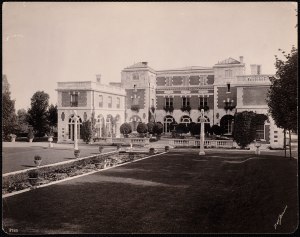
1989: Canyon Ranch, a leading health and wellness resort, opens at the Bellefontaine Mansion, built in 1897 by Giraud Foster as a “holiday cottage” and later operated as a seminary and a boarding school.
2016: Lenox’s dominant hospitality industry grows dramatically, as permits are issued for Lenox Manor, a 100-suite Element by Westin extended-stay hotel and event center on the site of the former Magnuson Hotel and Holiday Inn, among other operators. Also under construction are Courtyard by Marriott (opening this spring) and Miraval/Cranwell, owned by Hyatt Hotels, where an $80 million renovation is underway.
Sources: Lenox Library Archives; Images of America by Amy Lafave; Eagle archives and numerous primary and secondary sources.
Major Attractions
A sampling of unique places that have not only put Lenox on the map for visitors but also are cherished by the town’s residents:

Tanglewood: The Boston Symphony’s summer home since 1938 and site of the renowned Tanglewood Music Center, a conservatory for advanced young musicians, the performance center showcases not only the classics of Western art music but also a wide range of popular artists. Its season, originally six weeks, now extends from mid-June through Labor Day weekend and attracts about 350,000 listeners on average to nearly 100 events. Information: tanglewood.org.

The Mount: Site of the Edith Wharton Restoration, which has restored the famed author’s 1902 estate and gardens and hosts an expanding schedule of events and literary-oriented programs. Information: edithwharton.org

Shakespeare & Company: Housed at The Mount from 1980 to 1999, the regional theater at its Kemble Street home since 2000 offers a rotating repertory of The Bard’s works as well as contemporary theater at its Tina Packer Playhouse and Ellyn Bernstein Performing Arts Center. Information: shakespeare.org.

Ventfort Hall Mansion and Gilded Age Museum: The restored estate at 109 Walker Street built in 1893 for Sarah Morgan, the sister of J.P. Morgan, is on the National Register of Historic Places, offers guided tours as well as lectures, exhibits, performances and gala events. Information: gildedage.org.
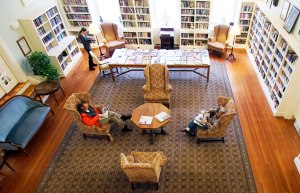
Lenox Library: A focal point of the town’s the intellectual, cultural and historical life, it provides informational resources in print and online with an extensive schedule of programs for community members. Includes historic archives, an extensive music collection, and books for all ages. Special events and talks are often held in the Reading Room and Welles Gallery. Open Tuesday-Saturday. Information: lenoxlib.org

Pleasant Valley: MassAudubon’s wildlife sanctuary on more than 1,000 acres offers year-round outdoor recreation on its network of trails through forests, meadows, wetlands, and slopes of Lenox Mountain. Visitors seek the best times, such as dusk, to spot industrious beavers and their dams, dens and lodges. Information: massaudubon.org.

Kennedy Park: Beloved by residents and visitors, this dog-walkers’ and hikers’ paradise of nearly 200 acres is owned and maintained by the town. The hardwood forest donated by John Drummond Kennedy in 1975 includes old carriage roads and nearly 15 miles of groomed trails. Multiple entrances are above Church on the Hill off Main Street, at the Arcadian Shop on Routes 7 and 20, and on West Dugway Road. The multi-use area is open sunrise to sunset; prohibitions include motorized vehicles, hunting, trapping, alcohol and fires. Information: townoflenox.com.

Historic Downtown Village: A mecca for dining out, shopping at The Bookstore, an array of boutiques, real estate offices and food and wine purveyors. The Gateways Inn, the Summer White House, Kemble Inn, Hampton Terrace B&B, Rookwood Inn, Whistler’s Inn, Village Inn, Cornell Inn, Birchwood Inn and the Garden Gables are among the in-town hostelries. The Historic District Commission oversees signage and preservation efforts. Off-street parking available at several municipal lots.
